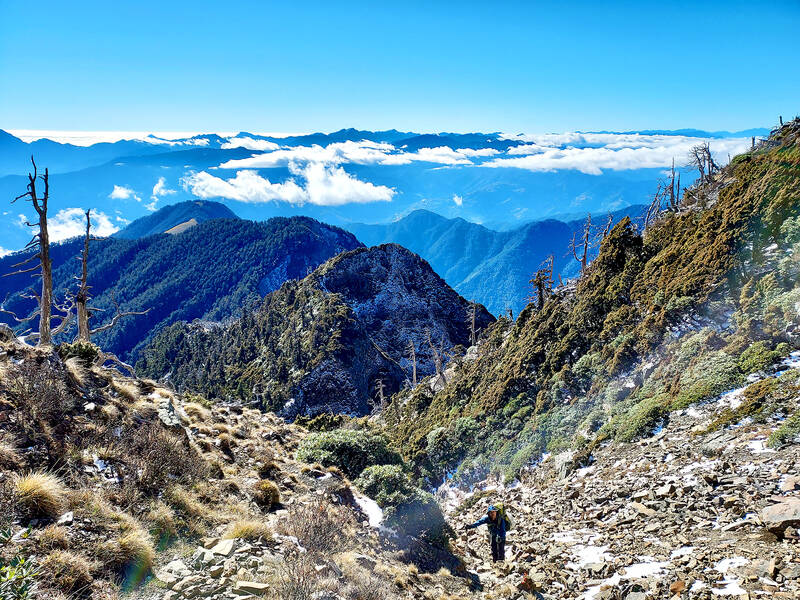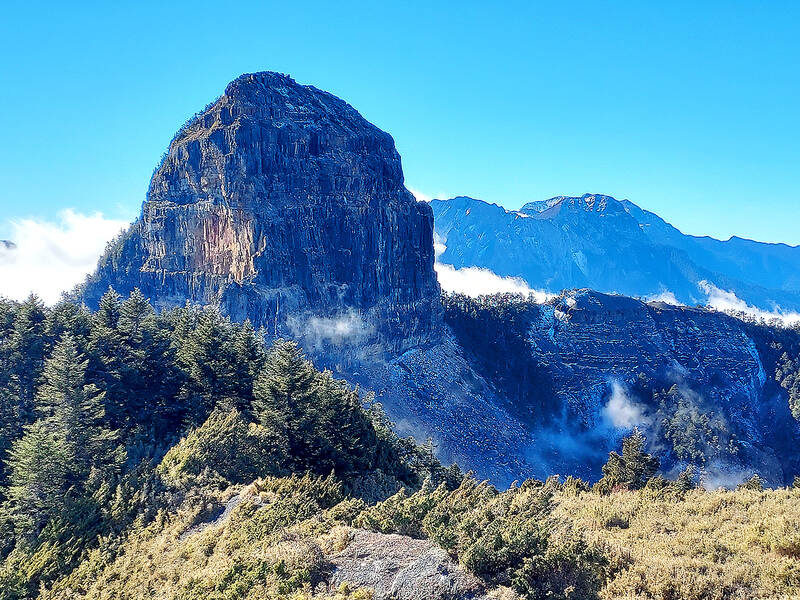This holy ridge!
How many people can bear the honor
of making the trek between these two mountains

Photo: Tyler Cottenie
and speaking of this ridge's true beauty?
These are the words that Numai Tetsutaro, a monopoly bureau employee during Japanese colonial rule and founder of the Taiwan Mountaineering Association, put to paper after summiting Dabajian Mountain (大霸尖山) in 1927 and gazing across the rugged ridgeline connecting it to Snow Mountain (雪山). He would never get the chance to walk this route and speak of its true beauty, but the name “Holy Ridge” (聖稜線) stuck. The first recorded traverse was made a few years later, and hikers have been drawn to this legendary hike ever since.
The advantages of this route are hard to overstate. For peak baggers, there are as many as eleven of the 100 Peaks of Taiwan up for grabs. Nowadays, there are enough cabins in the right places that it’s possible to sleep indoors every night. The scenery is rugged and beautiful, with rocky, exposed ridges that offer commanding views on both sides. Much of this beauty comes from the unusual patterns of erosion here that are evidence of past glacial activity. Famed Japanese naturalist Tadao Kano recorded 35 glacial cirques in the Snow Mountain area, of which more than a dozen are visible from the Holy Ridge.

Photo: Tyler Cottenie
O, Y AND I ROUTES
Though the Holy Ridge itself is the ridge connecting Taiwan’s second-highest mountain, Snow Mountain, with Dabajian Mountain, the various access trails and side peaks can be combined to form different itineraries. The three standard routes nowadays all start or finish at the regular Snow Mountain trailhead, and are named after the approximate shape they trace out on a map: O, Y and I. All require permits from Shei-Pa National Park.
The “O” and “Y” routes start and end in Taichung County’s Wuling Farm (武陵農場), simplifying transportation. The “O” route is the shortest and covers seven of the 100 Peaks, while the “Y” route adds a side trip of two more days and four more peaks. The “I” route covers seven peaks but exits in a different county on the other side of the island, complicating transportation. All treks offer similar views and you really can’t go wrong choosing a route.

Photo: Tyler Cottenie
For this author’s hike, we walked the entire Holy Ridge but opted for a non-traditional entry and exit point. We reached the peak of Snow Mountain by way of its south side, which was the standard access route during the Japanese era when the term “Holy Ridge” was coined. We were treated to excellent weather and a dusting of snow and ice: just enough to make the views even more magical but not enough to make this a truly death-defying hike, which — make no mistake — it certainly can be during the winter.
REACHING THE SUMMIT
The ascent up the south ridge of Snow Mountain is long and steep, taking at least a day and a half. It’s no wonder this is no longer the preferred access route. During the Japanese era, a cabin was constructed here that could hold up to 100 hikers. Unfortunately, no trace of the building remains today, but the site is now a wide flat area on an otherwise steep ridge, making for a lovely campsite, complete with nearby water source.

Photo: Tyler Cottenie
Between the campsite and the peak of Snow Mountain, we did not see a single person. For peace and quiet, this route sure beats the traditional route that over a hundred hikers take each day. As we neared the peak, we passed the treeline and continued walking up an exposed talus slope. Chunks of rock broken up from continual freeze-thaw cycles, landslides and wind erosion were strewn all around us, reaffirming how high we had ascended already and that the forces of nature up here were harsh and unforgiving, not only to life but to the land itself.
Upon cresting the peak, the landscape turned shockingly white. The Holy Ridge, now laid out in its entirety before our eyes, was covered in snow. We had crampons with us, as required by regulations, but even with crampons there are sections of the Holy Ridge where one missed step could mean the difference between getting home to write an article about the trip and plummeting to an untimely death. Filled with both awe and trepidation, we pushed onward.
HIKING THE HOLY RIDGE

Photo: Tyler Cottenie
The thing about the Holy Ridge is that you can never let your guard down. Immediately after a short descent from the peak, there is a tricky climb up a cliff using ropes. Luckily this cliff faces south so the snow and ice here had melted. After reaching the top, we could see a giant bowl of snow on either side of us: these are the two largest cirques carved out by glaciers millennia ago.
After passing the Syuebei (“Snow North”) Hut, affectionately known as the Fairy Tale Cabin, the terrain got more and more difficult. Every time the trail dipped over to the north side, we were faced with much heavier snow and ice. Near Sumida Mountain (素密達山), there is a rope ascent up a nearly vertical creek bed, followed by two fully vertical ascents up ladders.
This is not a trail for acrophobes. At the top of these ladders, the terrain is covered in boulders, there is no path to speak of and venturing too far off to either side results in a dizzying view down a cliff. Things were made more difficult by the patches of ice all around threatening to send us sliding away toward these very cliffs.
After safely passing through this most rugged and adrenaline-inducing section, the Holy Ridge descends into the forest past another cabin and comes out at the heavily eroded base of Dabajian Mountain. This stunning block of rock has sheer cliffs on all four sides and is one of the most photogenic peaks on the island. Ascents used to be possible via ladders, but these were removed in 1991 and summiting is now forbidden.
Hiking by the base is nevertheless a dramatic experience. On one side is a 100-meter-high wall of rock, and on the other is a talus slope dropping down to a creek far below. Evidence of recently fallen rocks is obvious right beside the trail so helmets are recommended. Water is often dripping onto the trail from the cliff face, and in winter this can leave a long strip of ice exactly covering the trail.
After passing by Dabajian, the Holy Ridge is officially over. If you go, don’t forget to turn around and look back: the whole route you just spent nearly three days walking is still visible, from the peak of Snow Mountain in the distance, to the treacherous Sumida Mountain slopes, to the showpiece Dabajian Mountain. Finish up the other peaks nearby and go home (“I” route), head toward the Wuling Four Peaks (“Y” route) or head down the less popular north ridge through thick bamboo to the towering cypress trees at the Jhensibao (鎮西堡) trailhead as the author did.
Whichever route you take, enjoy the honor of having completed one of Taiwan’s most legendary high-mountain hikes, and the privilege of having experienced the beauty that Numai Tetsutaro could only dream of nearly a century ago.

Most heroes are remembered for the battles they fought. Taiwan’s Black Bat Squadron is remembered for flying into Chinese airspace 838 times between 1953 and 1967, and for the 148 men whose sacrifice bought the intelligence that kept Taiwan secure. Two-thirds of the squadron died carrying out missions most people wouldn’t learn about for another 40 years. The squadron lost 15 aircraft and 148 crew members over those 14 years, making it the deadliest unit in Taiwan’s military history by casualty rate. They flew at night, often at low altitudes, straight into some of the most heavily defended airspace in Asia.

This month the government ordered a one-year block of Xiaohongshu (小紅書) or Rednote, a Chinese social media platform with more than 3 million users in Taiwan. The government pointed to widespread fraud activity on the platform, along with cybersecurity failures. Officials said that they had reached out to the company and asked it to change. However, they received no response. The pro-China parties, the Chinese Nationalist Party (KMT) and Taiwan People’s Party (TPP), immediately swung into action, denouncing the ban as an attack on free speech. This “free speech” claim was then echoed by the People’s Republic of China (PRC),

Many people in Taiwan first learned about universal basic income (UBI) — the idea that the government should provide regular, no-strings-attached payments to each citizen — in 2019. While seeking the Democratic nomination for the 2020 US presidential election, Andrew Yang, a politician of Taiwanese descent, said that, if elected, he’d institute a UBI of US$1,000 per month to “get the economic boot off of people’s throats, allowing them to lift their heads up, breathe, and get excited for the future.” His campaign petered out, but the concept of UBI hasn’t gone away. Throughout the industrialized world, there are fears that

Like much in the world today, theater has experienced major disruptions over the six years since COVID-19. The pandemic, the war in Ukraine and social media have created a new normal of geopolitical and information uncertainty, and the performing arts are not immune to these effects. “Ten years ago people wanted to come to the theater to engage with important issues, but now the Internet allows them to engage with those issues powerfully and immediately,” said Faith Tan, programming director of the Esplanade in Singapore, speaking last week in Japan. “One reaction to unpredictability has been a renewed emphasis on